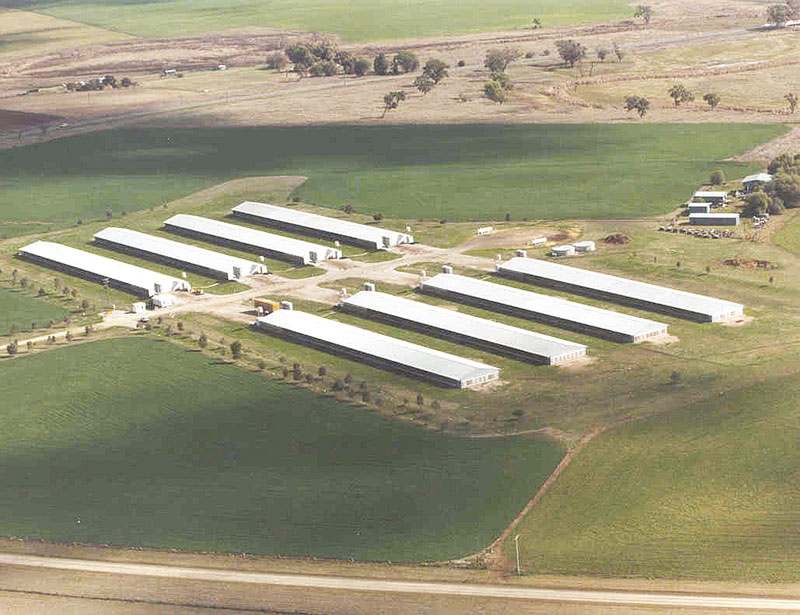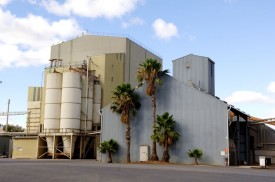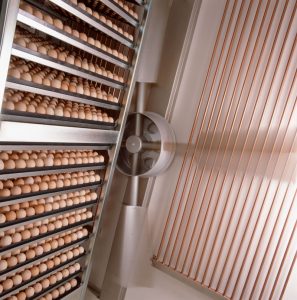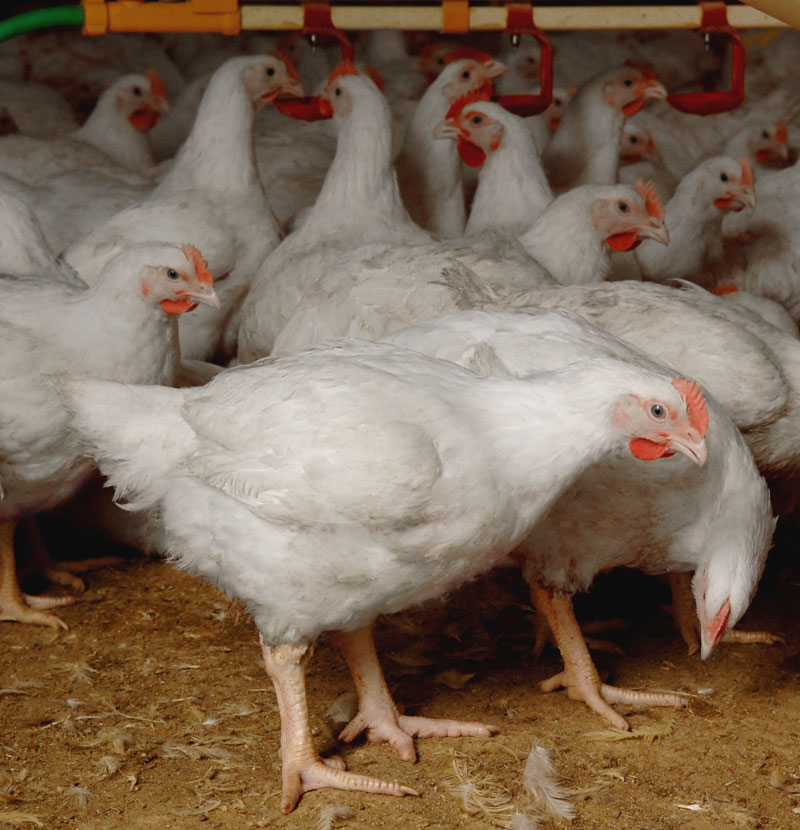Meat chicken (broiler) industry
Meat chicken (broiler) industry
Australia’s meat chicken industry, or broiler industry, has a relatively brief history when compared with the other major Australian livestock industries. There are currently more than 800 commercial meat chicken growers in Australia. Most grow chickens under contract to meat processing companies and are known as ‘contract chicken growers’. These producers grow 80% of Australia’s meat chickens.
There were no official government records until the mid-1960s, so the exact time when intensive poultry production began is not known. However, industry sources estimate that three million meat chickens were produced in 1951. Most commercial meat chicken farms are intensive, highly mechanised operations that occupy a relatively small area compared with other forms of farming. Commercial broilers are raised on litter floors (e.g. rice hulls, wood shavings) in large poultry sheds. Australian broilers are not kept in cages, regardless of the production system used. The main production systems are generally referred to as conventional, free-range and organic.

Aerial shot of a modern broiler farm
History of the meat chicken industry
The rapid expansion of the poultry industry took place in response to demand during the 1950s. Most production during this time was in the hands of ‘backyard’ producers and larger family operations. The larger operations were often involved in the production of chickens as an offshoot of their egg-producing activities as well as being producers and/or distributors of other livestock. The birthplace of the commercial industry was the outer Sydney metropolitan area, although other centres of commercial production quickly appeared near other major population centres.
In the decade 1950/51 to 1960/61, the size of the industry increased almost sevenfold. In the early 1950s, the first real efforts were made to develop an Australian meat chicken breed, resulting in the release of Australia’s first scientifically bred meat chicken strain in 1959. With the introduction of continuous chain processing systems, the processing of chickens became faster and more efficient and the resultant economies saw a rapid fall in the price of chicken to the consumer.
As a result of these developments and the rise of the ‘integrator’ in the industry, further expansion of the commercial industry occurred during the 1960s. These vertically integrated companies (fashioned on the highly successful US meat chicken company model) owned chicken breeding and hatching operations, feed mills and chicken processing plants and contracted out the growing of chickens from day-old to slaughter weight to ‘contract growers’.
The establishment of Kentucky Fried Chicken in Australia, with its first store opening in 1968, had a major impact on the consumption of chicken. In the 12 months from 1970-1971, a total of 75 stores were opened and during the same period, total Australian production increased by 38%.
Coupled with further improvements in the genetic material available, refinement of the nutrition and husbandry of broiler chickens, improvements in processing technologies and further growth in demand, the industry’s output increased more than five-fold in the 1960s and more than doubled again in the 1970s. It has continued to grow steadily, although less spectacularly, over the past 30 years.
Before 1960, the traditional roast chook eaten on special occasions was either a spent layer (boiler) or a male from a layer strain which was reared to about 12-14 weeks of age, especially for meat production. These male birds were crossbred layer strain birds, resulting from mating White Leghorn (WL) cockerels with Australorp (AL) hens. These are usually described in the industry as WL x AL, with the breed name of the cockerel being placed first and that of the hen last.
Structure and ownership of the meat chicken industry

The meat chicken industry now operates largely through vertical integration, with company ownership of breeding farms, multiplication farms, hatcheries, feed mills, some broiler growing farms and processing plants. Three large integrated companies supply about 80% of broiler chickens marketed in Australia. The biggest of these three companies is Inghams Enterprises, followed by Bartter Enterprises and Baiada. All three of these companies are privately owned and each has farming and processing operations in at least three states. The balance of output is shared among seven medium-sized companies (each supplying between 1-3% of the market nationally), and a myriad of smaller processors.
Processing companies generally contract out the growing of their broiler chickens to contract chicken growers. These growers own the farm and provide the management, shedding, equipment, labour, bedding and other inputs for the rearing of the chickens. The processing company provides, and at all times owns, the chickens and provides the feed, medication and technical advice. Contract growers are paid a growing fee which currently varies from 59-73 cents per bird. The terms and conditions of the grower contracts, as well as the growing fees, are established by state government constituted committees in some states, or by negotiation between growers or groups of growers (under authorisation by ACCC) and companies in other states.
The payment generally includes a performance-based component. Approximately, 800 growers produce about 80% of Australia’s meat chickens under contract to processing companies. The majority of meat chickens are produced on large company farms, or on farms owned and managed by ‘intermediary’ companies which own a number of farms, each managed by a farm manager, and who enter into contracts with the processing companies to grow out chickens on a larger scale. The three major poultry producing companies also own their own breeding farms, supplemented by some contract operators, and supply eggs to their company’s hatchery. These companies also own their own feed mills in at least some of the areas in which they operate and have their own laboratories to test samples for common poultry pathogens and other bacteria. Several companies have their own research farms. A number of the medium-sized companies also possess their own parent breeding farms and, in some cases, hatcheries. Each of the larger companies operating in the industry also has a product research and development facility.
Chicken is marketed throughout Australia by the large and medium sized integrated companies under various brand names through numerous

outlets. Brands range from nationally recognised names to state recognised names and house brands. Numerous smaller processors also market chicken either under their own particular brand or in some cases without any brand identification, other than their name and address on the original packaging.
A completely vertically integrated company would operate:
- Feed Mill – producing feed for breeders and meat chickens
- Breeding Farms – producing fertile eggs
- Hatchery – producing day-old chicks
- Growing Farms – producing the end product i.e. chicken meat
- Processing Plant – to process and market chicken meat
- Veterinary Services
- Transport
Meat chicken industry locations
Major centres of chicken meat production have developed adjacent to the major capital cities, although the industry is becoming more regionalised as those areas become increasingly urbanised. Poultry processing plants, together with all the other component activities in areas in an integrated operation, have developed in proximity to markets and a ready source of labour. Many of the largest operations are established in, or within a 50 km radius of capital cities. The obvious advantages are in distribution costs associated with transport of the end product, labour availability and services.
Hand-in-hand with the siting and location of poultry processing plants is the siting and location of chicken grow-out farms. Processing companies, either totally integrated or independent processors, prefer the meat chicken growing farms that supply them to be located relatively close to the processing plant – preferably within about a 100 km radius, or two hours travelling time, of the plant. As with any farming operation, certain factors are desirable, if not essential, including:
- proximity to a feed mill
- guaranteed supply of electric power
- guaranteed water supply
- accessibility to heavy transport, realising the need for access for both fully laden feed trucks and live poultry haulage vehicles
- availability of a source of labour, depending on farm size
- availability of other services such as tradesmen, servicemen and veterinarians
Major areas of meat chicken growing are:
- outskirts of the Sydney metropolitan area, Mangrove Mountain / central coast, Newcastle, Tamworth and Griffith areas of NSW;
- Redland Bay south of Brisbane, and other areas to the south, south-west and north of Brisbane in Queensland;
- Mornington Peninsula, east of Melbourne, and Geelong and Bendigo areas in Victoria;
- outskirts of Adelaide and the Two Wells area in South Australia;
- outer metropolitan areas of Perth.
Smaller pockets of chicken meat production are found in the northeast corner of NSW surrounding Byron Bay, Mareeba in Queensland and Tasmania.

Meat chickens or 'broilers'
Growing meat chickens
There has been tremendous improvements in the genetic potential and nutrition of meat chickens over the past 50 years. Meat chickens today can reach a weight of approximately 2.2 kg in 35 days while consuming only 3.3 kg of feed. Genetic selection is still leading to improvements in performance and the time it takes to reach market weight is gradually becoming shorter.
- In Australia, meat chickens are farmed in large open poultry houses called ‘sheds’, ‘houses’ or ‘units’. Shed sizes vary, but a typical new shed would be 150 metres long and 15 metres wide and hold about 40,000 chickens. The largest sheds can contain up to 60,000 meat chickens.
- There may be between 3 and 10 sheds on one farm. Typical new farms house approximately 320,000 chickens.
- Feed and clean water are available to the chickens 24 hours a day, although some operators make the feed available at a number of discrete ‘meal times’ each day.
- The chickens have adequate lighting to see by and to find feed and water, with some periods of darkness each day to allow them to rest and to avoid panic in the event of a blackout. The lighting provided is usually dimmer than natural lighting, as dimmer lighting tends to promote calmness in flocks of meat chickens.
- Regular checks are made of the shed temperature, humidity and air quality and each parameter is adjusted according to requirements. In many sheds, these factors are monitored automatically and adjusted by computer controllers.
- All mechanically operated sheds have back-up electricity and alarm systems which alert if there is a problem with the functioning of the shed or supply of inputs to it.
- The flocks are also checked regularly (usually daily) to monitor health and progress, to remove any dead birds, and to cull any sick or injured ones.
- Feeders and drinkers are regularly checked to ensure that they are working and to correct any spillages. Careful management of ventilation and drinkers helps to maintain the litter in a clean, dry and friable (easily crumbled) condition. Poor litter management will impact on air quality and can lead to reduced bird health and performance as well as carcass downgrading at the processing plant.
- Over the life of the broiler flock, only about 4% of chickens are lost and these are through natural causes or culling.
Why do chickens grow to market weight so quickly?
Around 50-60% of the improvement in growth rates since the start of intensive poultry farming is due to improved breeds of chickens. This genetic gain, which has been achieved through conventional selective breeding, is due to:
- Investment in advanced breeding programs by the large well-resourced specialist breeding companies overseas.
- The number of generations that can be produced in a relatively short period of time. Chickens reach sexual maturity at about 20-25 weeks of age, then take only three weeks to start producing the next generation. Each hen can produce up to 150 progeny within a year of its own hatching.
A further 20-25% of the improvement in growth is due to improved nutrition. For current meat chicken breeds, the requirement of nutrients such as energy, protein, essential amino acids, vitamins and minerals at each stage of its growth has been studied precisely. For each feed ingredient, the levels of these nutrients digestible by the chicken has also been established. With this information, feed can be formulated to match the chicken’s precise nutritional requirements throughout its life cycle without excesses, thereby optimising growth and feed efficiency. Other gains made in meat chicken growth and performance are due to better husbandry techniques and health management.
Litter quality in meat chicken house
Wet litter is a worldwide problem (including Australia) for fast-growing meat chickens in a deep litter system. It is important to maintain the litter in a dry and friable condition in meat chicken houses. Wet litter increases odour and ammonia emissions, resulting in poor performance and welfare of birds, which affects the product quality due to breast blisters and foot pad dermatitis in birds.
Industry position statement on hormones in chicken meat
(This content has been provided by Dr Vivien Kite, Australian Chicken Meat Federation)
- Definition – Animals produce hormones naturally to regulate their body’s biochemistry. If hormones – either synthetic or natural – are introduced into an animal, they can modify the animal’s metabolism. This can have a range of effects, including changing its growth rate.
- Situation Analysis – No hormones are fed or otherwise administered to any poultry in Australia. Hormones have not been used in the Australian poultry industry for more than 40 years. Hormones were originally used as an alternative to castration to improve the tenderness of the meat, but improved breeds of chicken have made this practice unnecessary.
- Policy Statements on Hormones – No hormones are administered to meat chickens under any circumstances. There is no basis for any food safety concern regarding hormones.

